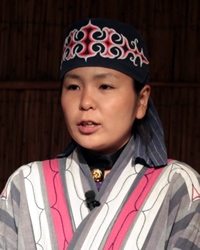The origin of the Ainu is a mystery. Initially, the Ainu looked more like Europeans than Asians. Their history probably dates back 15,000 years. There are two theories about their origin. The first is the "northern theory" - namely, that they came from the land in the north, later settled by the Mongols and Chinese. The second is that their ancestors are from Polynesia because the Ainu have many similarities in dress, rituals, religion and tattoos to the inhabitants of Oceania.
Under the terms of the Treaty of St. Petersburg of 1875, the Kuril Islands were ceded to Japan along with the Ainu living on them. On September 18, 1877, 83 North Kuril Ainu arrived in Petropavlovsk-Kamchatsky, deciding to remain under Russian rule. They refused to move to reservations on the Commander Islands, as the Russian government had offered them. After that, from March 1881, for four months, they walked to the village of Yavino, where they later settled. Later, the village of Golygino was founded. Another 9 Ainu arrived from Japan in 1884. The 1897 census indicates a population of 57 in Golygino (all Ainu) and 39 in Yavino (33 Ainu and 6 Russians). The Soviet authorities destroyed both villages, and the inhabitants were resettled in Zaporozhye, Ust-Bolsheretsky District, Kamchatka Krai. As a result, three ethnic groups assimilated with the Kamchadals. At some point, it became shameful and simply dangerous to call oneself an Ainu - many of them assimilated, learned Russian and became Orthodox Christians.
The Ainu live in in Sakhalin, the Kuril Islands, the Kamchatka Peninsula, and in Khabarovsk Krai. However, most live in Japan. Very few are in Russia.
Most of the Japanese living in Russia are of Ainu descent, although they do not recognize it (full-blooded Japanese are allowed to enter Japan without a visa). During the 2010 census, about 100 people attempted to register themselves as Ainu, but the government of Kamchatka Krai rejected their claims and recorded them as Kamchadals. Additionally, many local people are ethnically Ainu or have significant Ainu ancestry, but identify as various recognized groups, such as Nivkhs and speak Russian as mother tongue, often not knowing about their Ainu ancestry. The ethnic Ainu of the Sakhalin Region and the Khabarovsk Territory are not organized politically. Alexei Nakamura reports that in 2012 there were 205 Ainu in Russia (compared to 12 people in 2008), and they, like the Kuril Kamchadals, are fighting for official recognition.
Most Ainu in Russia have maintained their traditional shamanistic religion.
The Ainu language is a language isolate, having no known relationship with any other languages. In the 21st century, the language was preserved only on the island of Hokkaido in Japan, but, most likely, today there are no Ainu speakers left. The Ainu language became extinct in Russia many decades ago. In Russia they stopped speaking their language at the beginning of the 20th century. In 1979, only three people on Sakhalin could speak Ainu fluently, and the language probably became completely extinct by the 1980s.
Pray for the Lord to abundantly bless the Ainu people in Russia in such a way they will give him their full allegiance.
Pray there will soon come a day when Ainu Christ followers will disciple others in his ways.
Pray for a spiritual revival among the Ainu in Japan and Russia.
Scripture Prayers for the Ainu (Japan) in Russia.
https://estatelite.ru/en/ainy-aborigeny-yaponskih-ostrovov-ainy---kto-oni-kurilskie-ainy/
https://en.wikipedia.org/wiki/Ainu_people
https://www.rbth.com/lifestyle/330576-who-are-ainu-people
Kyle Eipperle
| Profile Source: Joshua Project |











